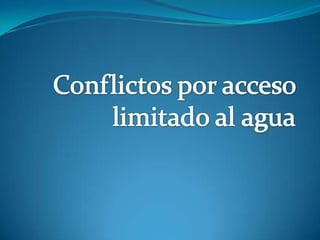
Conflictos por acceso limitado al agua
- 2. Ríos Éufrates y Tigris
- 4. LONGITUD DE LOS RIOS POR PAIS Rio Turquía Siria Irak Total Éufrates 1.230 km 41% 1710 km 24 % 1.060 km 35% 3.000 km Tigris 400 km 22% 44 km 2% 1.418 km 78$ 1.862 km
- 5. ESTUDIO DE LAS POSIBLES CAUSAS DE CONFLICTO EN LA CUENCA: ASPECTOS AMBIENTALES, SOCIALES, ECONÓMICOS E INSTITUCONALES Aspectos ambientales Aspectos sociales Aspectos socio-económicos Aspectos institucionales Presa de Ataturk
- 7. Factores que contribuyen a hacer de la escasez de agua una fuente potencial de conflicto El agotamiento o degradación del recurso El crecimiento demográfico La distribución o el acceso desigual.
- 8. Conflictos Israel-Jordania 15 de mayo de 1948: marcó una nueva etapa para los conflictos en las relaciones internacionales del Medio Oriente, cuando David Ben Gurión declaró la independencia del Estado de Israel. 1960, un consejo técnico de la Liga Árabe preparó un proyecto para incrementar el aprovechamiento de las aguas del río Jordán entre sus tres vecinos: Sira, Jordania y Líbano. Sin embargo, Jordania ya tenía un proyecto entre manos, “el gran proyecto del Yarmouk”, que se preparaba para el desvío de las aguas del río Jordán. El proyecto árabe comenzó sus primeros trabajos en el año de 1965. 1967 :En la Guerra de los Seis Días–iniciada por los ataques israelíes contra Egipto y Jordania-, la victoria israelí tuvo como consecuencia el control del río Jordán y la continuación de sus proyectos hidráulicos
- 9. Los usos de agua por sector en Israel, Palestina y Jordania (hm3/año). Doméstico % Agrario % Industrial % Total Total per capita m3/año Israel* 667 34,5 1.141 59 124 6,5 1932 304 Cisjordania* 57 43 76 57 Incluido en 132 60 * domestico Franja de 60 41 85 59 Incluido en 145 117 Gaza** domestico Palestina** 117 42 161 58 Incluido en 277 80 Doméstico Jordania*** 241 27 623 69 34 4 898 190 Fuente: *(CBS) (2003). **(PCBS) (2000). ***World Bank Report (2001).
- 10. FACTORES DE EQUIDAD Geografía Hidrología Clima Población Israel 9 12 10 16,4 Árabes 91 88 90 83,6 TOTAL 100 100 100 100 Geografía: Proporción de superficie de cada país que ocupa en la cuenca Hidrología: Contribución hídrica de cada país a la cuenca Clima: Pluviometría de cada país en la cuenca Población: Proyección de población para el 2015
- 12. El Nilo es el río más largo del mundo. La Cuenca del Río Nilo tiene una longitud de más de 6500 kilómetros, se origina en la Región de los Grandes Lagos y llega hasta el Delta del Nilo en la costa del Mar Mediterráneo en Egipto. Diez países comparten la Cuenca del Nilo: Burundi, República Democrática del Congo, Egipto, Eritrea, Etiopía, Kenia, Ruanda, Sudán, Tanzania y Uganda.
- 13. De las 300 millones de personas que viven en los diez países que comparten las aguas del Nilo, unos 160 millones viven dentro de los límites de la Cuenca. La distribución de la aguas del Nilo está condicionada por los Tratados establecidos por Gran Bretaña, en 1924 y 1959, favoreciendo a Egipto y Sudán. En las asignaciones de agua a utilizar, a Egipto se le otorgó una cuota de 55.5 billones de metros cúbicos de agua anuales y a Sudán 18.5 billones.
- 14. Egipto utiliza actualmente la mayor parte del caudal del Río Nilo, pudiendo sufrir severas restricciones de agua si otros países. Los Tratados también establecen que cualquier país situado en la Parte Alta del Nilo deberá tener la aprobación de Egipto y Sudán para construir represas o cualquier obra de irrigación importante que pueda afectar las aguas del Río Nilo. La Iniciativa de la Cuenca del Nilo, lanzada en 1999, es un programa conjunto de acción entre los diez países ribereños del Nilo, que pretende garantizar: el desarrollo sostenible del recurso, la seguridad, la cooperación y la integración económica.
- 15. Regencias Bibliográficas Estudio de caso sobre recursos hídricos: ¿Dónde se comparten los recursos de agua a través de las fronteras nacionales?. Recuperado el 15 de julio de 2012 por: http://cgge.aag.org/WaterResources1e/cs-1esp/cs-1esp6.html El agua en la cuenca del rio Jordán: la lucha por un recurso escaso. Recuperado el 15 de julio del 2012 por: http://ddd.uab.cat/pub/papers/02102862n46/02102862n46p121.pdf El reparto del agua en la cuenca del Jordán. Recuperado el 16 de julio del 2012 por: http://www.fundacionsistema.com/media/PDF/Ppios15_Majed.pdf